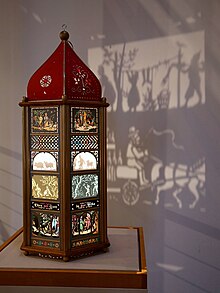Sebnitz shadow play
The Sebnitzer shadow plays emerged as Christmas folk art at the beginning of the 19th century . The distribution was narrowly limited regionally around Sebnitz . The Sebnitz shadow play has a paper casing. The frame is made of wood. The paper walls and the roof are provided with ornamental cuts and illuminated images. Outwardly it resembles a large lantern with different tower or temple-like shapes. Inside the play of shadows, a drum made of wood or wire rotates, which is driven by the rising heat of a candle or oil lamp through an impeller attached to the top. The wooden central axis of the drum runs in a guide above and below, and at the bottom it ends in a needle that stands on a broken glass. Are cut on the outer walls of the drum in several floors on wood tire cutouts mounted. To prevent the figures from twisting, they are attached to wire or gauze. The light from the candle or oil lamp casts the shadows of the rotating paper cuts on openings in the housing wall that are covered with transparent paper. The moving, running shadow images create a fascinating effect.
The Sebnitz silhouette artist Adolf Tannert (1839–1913) had a decisive influence on the design of the shadow plays .
The first dated shadow play with paper cuttings by Adolf Tannert comes from the year 1856. There are also shadow plays from the middle of the 19th century whose figure strips were not cut by Tannert. The shadow playmakers, as few surviving examples show, cut them out of picture sheets and playing cards and stuck them on the tires. The resulting stripes of figures were small pictorial scenes.
literature
- Hansjörg Hertwig: Sebnitz shadow games - a unique folk art. Self-published, Sebnitz 2012
